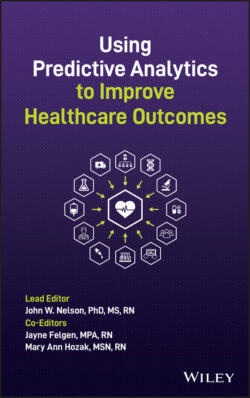Читать книгу Using Predictive Analytics to Improve Healthcare Outcomes - Группа авторов - Страница 29
Step 12: Present Data to the People Who Work Directly With the Variable of Interest, and Get Their Interpretation of the Data
ОглавлениеUltimately, the most relevant and useful interpretation will be provided by those who live the clinical experience, because they can validate or refine the interpretation of the data. These people are typically clinicians, not analysts, however, so showing complex data in a format that is accessible to the employee not trained in analytics is important. When possible, use bubble graphs that provide a visual review of overall findings.
Figures 1.2 and 1.3 convey two ways to facilitate understanding of complex mathematics. Figure 1.2 provides a visual representation of the traditional graphic for results from a regression equation which examined three predictor variables related to reduction of central line‐associated blood stream infection (CLABSI). The three predictors—location of the central line insertion, the RN assigned, and the phase of the project—have been tested to see the degree to which each of them explains the frequency of CLABSI.
Similarly, Figure 1.3 is a bubble graph which also shows how much of the outcome variable is explained by the same three predictor variables.
Figure 1.2 Explained variance of CLABSI, traditional graphic.
Figure 1.3 Explained variance of CLABSI, bubble graphic.
Both models reveal that the location of the central line insertion predicted 2.2% of CLABSI, the assigned RN predicted 1.1%, and the phase of the project predicted .4%. It has been the experience of this author that the visual representation in Figure 1.2 does not convey information as quickly as does the visual representation in Figure 1.3, in part because it relies too heavily on statistical symbols and equations to convey the information. In this book, however, you will see that most of the graphic representations of models and their results are expressed in traditional graphs, as many readers are likely to want more information than bubble graphs convey.
Analysts can provide a review of the results, but it is only the staff members who can provide validation or reflections that may suggest the need for secondary analysis to understand the data more deeply. When the data is being presented, pay attention to the listeners' responses. Even people who do not want to speak up may provide useful insight through nonverbal responses such as silence or even a shift in energy in the room. All of these cues can be informative. It is not uncommon for this author to pull listeners aside to discuss the nonverbal cues or silence that was observed. When encouraged to express themselves, these are often people from whom extremely valuable feedback is elicited.
